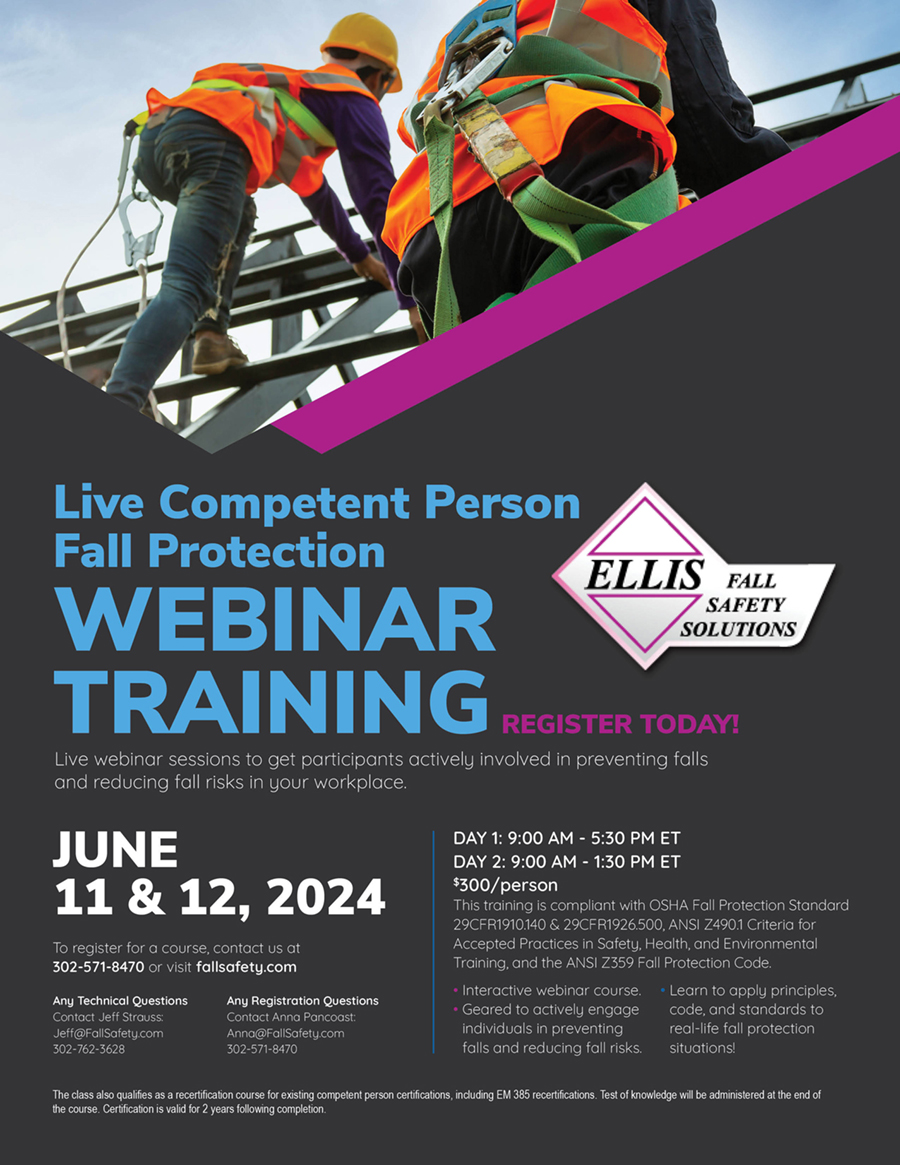Tip of the Week No. 241 – 03/09/09 – Stepladders
By their nature, stepladders have a stable angle and are self-supporting when properly used, but offer very little opportunity to be secured from tipping.
Therefore, the height limitations for such usage should be minimized, possibly to a maximum working height of 6 feet (or an 8-foot stepladder).
Railed stepladders with depressible casters offer more opportunity for safe access to heights. These ladder stands should be replaced by elevating platforms to reduce training and observational burdens.
See “Introduction to Fall Protection, 3rd Edition” page 89.
This book is an invaluable resource for every safety manager’s library. Click here to find out about ordering a copy. Order online now.
Tip of the Week No. 187 – 11/26/07 – Ladders
Job-made Ladder:
A ladder that is fabricated by carpenters, typically at a construction site for a specific location, and is not commercially manufactured. Job-made ladders can be single- or double-cleat design, with the latter offering a center rail to allow simultaneous two-way traffic ascending and descending to a specific access point.
See “Introduction to Fall Protection, 3rd Edition” page 430.
This book is an invaluable resource for every safety manager’s library. Click here to find out about ordering a copy. Order online now.
Tip of the Week No. 100 A – 01/23/06 – Ladder Cages
Basketcage protection consists of metal hoops installed around fixed ladders according to OSHA requirements (1910.27).
This arrangement offers the advantage of one-time installation, low maintenance and little or no training requirements.
ANSI A14.3-1992 permits climbing protection systems to be used with cages for more safety. This becomes positive protection.
See “Introduction to Fall Protection, 3rd Edition” page 248.
This book is an invaluable resource for every safety manager’s library. Click here to find out about ordering a copy. Order online now.
Tip of the Week No. 106 A – 03/27/06 – Ladders
Normally, it is recommended that a ladder be placed at an angle of about 75 degrees (or a ratio of 4:1 for the working length compared to the distance from the ladder support base).
This angle minimizes tipping (when the ladder is too steep) and slipping (when the ladder is too flat).
In addition, the climber, when facing the ladder, has a support to fall onto, which may allow enough reaction time to grab a rung.
See “Introduction to Fall Protection, 3rd Edition” page 90.
This book is an invaluable resource for every safety manager’s library. Click here to find out about ordering a copy. Order online now.
Tip of the Week No. 60 A – 02/28/05 – Ladders
Ladders compromise an almost infinite combination of steps and handholds for ascent and descent from one level to another.
In general, there are 12 inches between each level and the horizontal gripping element and foot placement are rungs.
Rungs are supported by side rails at each end, typically 16-18 inches apart.
If ladders can be moved by hand or crane, they are called portable. If they are bolted or welded to the structure, they are called fixed. Sidestep refers to rungs that continue up and the climber steps to a platform at the side. A walk-through is a series of rungs that stop, but the side rails continue up and the climber exits to a platform between the side rails.
See “Introduction to Fall Protection, 3rd Edition” page 85.
How about ordering a copy of for yourself? Order online now.
Tip of the Week No. 62 A – 03/14/05 – Ladders
When offset ladders are used at heights beyond 14 feet, the second ladder must have a distance of 4 feet or more to the platform guardrail. If the distance is less than 4 feet the cage must extend to meet the guardrail for protection from falling beyond the platform. Addition of a climbing protection is the most economical solution.
See “Introduction to Fall Protection, 3rd Edition” page 248.
How about ordering a copy of for yourself? Order online now.
Tip of the Week No. 65 A – 04/04/05 – Ladders
Portable ladders may have alternating treads for secure foot placement between 50 and 70 degrees from the horizontal.
When railed and permanently secured, these present a better option for safer climbing in confined areas than do standard ladders.
OSHA, in the proposed 1910 Standard, Walking and Working Surfaces (April 10, 1990), classifies these as alternating tread stairs.
See “Introduction to Fall Protection, 3rd Edition” page 90.
How about ordering a copy of for yourself? Order online now.
For Roof Access Safety Find Out More About HatchGrip!!
The Ellis Ladder Improvements, Inc. safety device, HatchGrip provides the added fixed ladder safety and security you need when getting on to or off of a roof through a hatch.
To find out more go on this web site to HatchGrip Product Information.
To see photos of HatchGrip in use go on this web site to HatchGrip in use.
Safety News Item – 12/02/05 – Ladder Recall
On November 23, 2005 the US Consumer Products Safety Commission (CPSC) issued a voluntary recall of @ 3,000 Type 1A industrial use ladders.
According to the CPSC the rungs near the side rails could break causing a fall hazard.
For the full recall notice go to Ladder Recall.
Tip of the Week No. 63 – 04/04/05 – Ladders
Only ladder rungs meeting OSHA and ANSI standards should be held while climbing.
Because of the narrow climbing surface, the hands must grip securely to avoid a fall.
Only on horizontal bars are the hands reliable for holding the body weight for a brief time (sufficient for the feet to regain the rung). However, a near-veritcal bar cannot be held securely in any fall situation.
Sloped rails have been shown to be appropriate up to a certain pitch.
See “Introduction to Fall Protection, 3rd Edition” page 88.
How about ordering a copy of for yourself? Order online now.
Safety News Item – 02/04/05 – Fixed Ladder Cages
The UK Health and Safety Executive in late 2004 issued Research Report 258 entitled “Preliminary investigation into fall arresting effectiveness of ladder safety hoops.”
This UK report confirms the minimal reliability of fixed ladder cages as a fall arrest device.
For the full 223 page report go to HSE Report 258.
Safety News Item – 01/28/05 – GrabSafe and HatchGrip
Grabsafe and Hatchgrip meet the US Army Corps of Engineers specifications for ladders and hatches for the Army and Navy.
These patented devices for new or existing fixed ladders and hatches increase the ease of use and safety.
To find out more about these life saving products go to Grab Safe for Ladders. on this website.
Tip of the Week No. 28 – 06/21/04. Ladders.
Climbing ladders should be done with the free use of both hands and feet, to allow three-point control at all times, including access and exit. This helps to emphasize that most ladders are for access only and not for working on.
See “Introduction to Fall Protection, 3rd Edition” page 93.
How about ordering a copy of for yourself? Order online now.
Tip of the Week No. 13 – 03/08/04. Ladders.
Climbing ladders should be done with the free use of both hands and feet, to allow three-point control at all times, including access and exit. This helps to emphasize that most ladders are for access only and not for working on.
See “Introduction to Fall Protection, 3rd Edition” page 93.
How about ordering a copy of for yourself? Order online now.
Safety & Health Magazine: Ladder-safety expert wants to correct, add info.
Safety & Health Magazine: Ladder-safety expert wants to correct, add info.
Tip of the Week 318 – 05/21/2012 – Ladders
Normally, it is recommended that a ladder be placed at an angle of about 75 degrees (or a ratio of 4:1 for the working length compared to distance from the ladder support base). This angle minimizes tipping (when the ladder is too steep) and slipping (when the ladder is too flat).
In addition, the climber, when facing the ladder, has a support to fall onto, which may allow enough reaction time to grab a rung.
Introduction to Fall Protection, 4th Edition page 127.
Introduction to Fall Protection, 4th Edition now available for purchase.
To order your copy call 1-800-372-7775 or order online at Introduction to Fall Protection, 4th Edition Orders.
Tip of the Week No. 301 – 11/15/10 – Ladders
Climbing ladders should be done with the free use of both hands and feet, to allow three-point control at all times, including access and exit. This helps to emphasize that most ladders are for access only and not for working on.
See “Introduction to Fall Protection, 3rd Edition” page 93.
This book is an invaluable resource for every safety manager’s library. Click here to find out about ordering a copy. Order online now.
Tip of the Week No. 312 – 02/28/2011 – Job Made Ladders
A job-made ladder is a ladder that is fabricated by carpenters, typically at a construction site, and is not commercially manufactured. Job-made ladders can be single or double-cleat design, with the latter offering a center rail to allow simultaneous two-way traffic ascending and descending to a specific access point.
See “Introduction to Fall Protection, 3rd Edition” page 430.
This book is an invaluable resource for every safety manager’s library. Click here to find out about ordering a copy. Order online now.
Tip of the Week No. 335 – 10/22/2012 – Ladders
Ladders are designed to provide means of access only. A ladder is subject to ladder rules only (and not fall protection standards) when a person has three-point control. This means that a climber must have two feet and one hand on the rungs, or one foot and two hands on the rungs for ladder rules to apply. There is a -foot fall protection rule that applies to construction work, whereas there is a no-limit rule that applies to portable ladders in construction (subject to manufacturer’s instructions).
See “Introduction to Fall Protection, 4th Edition” pages 123-124.
Introduction to Fall Protection, 4th Edition now available for purchase. To order your copy call 1-800-372-7775 or order online at Introductionto Fall Protection, 4th Edition Orders.
Tip of the Week No. 346 – 01/07/2013 – Ladders
Job-made ladders are through-ladders, meaning the side-rail extension above the landing permits stepping directly onto the landing from the top rung. The hands are used to pull the body forward, provided the side rails are no bigger than 2 inches by 4 inches at that part of the ladder. It is important that the top step is flush with the landing to avoid tripping when descending and to avoid the enticing sidestep around the side rail.
See “Introduction to Fall Protection, 4th Edition” page 129.
Introduction to Fall Protection, 4th Edition now available for purchase. To order your copy call 1-800-372-7775 or order online at Introductionto Fall Protection, 4th Edition Orders.
Please select a category from the list below
- Aerial Lifts/Platforms
- Anchorage Points
- Calculations
- Construction Contracts
- Consulting
- Cranes
- Descent Devices
- Ellis Articles
- Ellis Presentations
- Equipment Maintenance
- Ergonomics/Human Factors
- Fall/Safety Statistics
- FP systems, programs
- Guardrails
- Harnesses, FP Equipment, HLL, SRL
- Hazards
- Holes/Pits
- Ladders
- Lanyards/Twin Tail Lanyards
- Misc.
- Nets
- New
- NIOSH
- OSHA News/Citations
- PFAS
- Rescue
- Roofs
- Ropes
- Safety Cases
- Safety Organizations
- Scaffolds
- Skylights
- Stairs
- Standard/Regulations
- Steel Erection
- Tanks
- Towers
- Training
- Tree Stands
- Trucks
- Tying Off
- Veterans of Safety
- Window Cleaners
- Workers Comp

